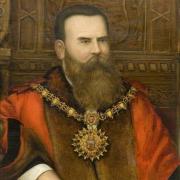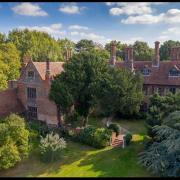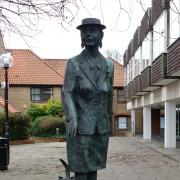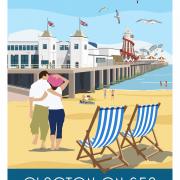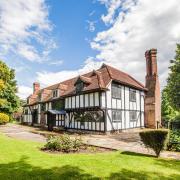Rather unkindly dubbed 'the fat man of Maldon', Edward Bright was a loveable local whose story lives on in in the town today
Ever since our lovely editor asked me to write about Essex Greats, I’ve been pondering what exactly makes someone great. Opinions differ, of course, and selecting people has to be subjective. Whilst there will be no doubt about some people’s credentials, there are others who may achieve notoriety but are not necessarily viewed as ‘great’. Take an individual, for example, who weighed in at an impressive 47½ stone.
Edward Bright was born in Maldon in 1721, although the date of that esteemed event is unknown. It’s believed he was a post boy growing up, riding daily to Chelmsford, and then, aged 12, was apprenticed to a Maldon grocer, Joseph Pattison. Aged 13 he witnessed a will, confirming his maturity and trustworthiness. He became a grocer and candle merchant and a respected Freeman of the Borough. One’s tempted to speculate that perhaps he consumed too many of his comestibles. Of course, there was no refrigeration in Bright’s day so it must have been tempting to eat stuff before it went off.
Unsurprisingly, given his size, he was dubbed the ‘fat man of Maldon’, although that seemingly unkind moniker was also his claim to fame. He wasn’t just Maldon’s fattest, but also reputedly the kingdom’s fattest. Why Bright was so big remains mysterious. This was when people were fitter because they walked, not having today’s cars for the lazy attainment of small distances. He was also a working man so would have been on his feet a lot. The fact Bright was so big must have made him stand out back then. He was also tall for the time, about 5 foot 9, the same as your scribe. A tape measure around his tum would have extended to nearly seven feet – quite the circumnavigation.

Bright lived and worked in Maldon’s High Street, No. 57-59, Church House, adjacent to Thomas Plume’s Library, which presumably had stout coat hangers as his overcoat was apparently large enough to accommodate several persons of ‘regular’ size. His fame was such that his portrait was painted in 1750, sadly not long before he died. The artist was David Ogbourne (1700-68). Various etchings of Bright would be completed thereafter, presumably based on this original artwork, including by James McArdell (1728-65), an Irish engraver in 1750, and Anthony Walker the following year.
There’s a sad end to this larger-than-life tale as Bright’s life was not destined to be long. He died on 10 November 1750 aged probably 29, and was buried in All Saints church in Maldon two days later. Dying aged 29 wasn’t such a surprise back then, average life expectancy being only 35-40. You’d think the reason for Edward’s premature demise was clear enough, but it wasn’t because of his size. He died of typhoid, which would have been a compelling reason to get his body in the ground quickly.

We know Bright’s body required a ‘special coffin’, 3ft 6” wide, and that access to his premises had to be especially cut by taking away some wall and staircase. The coffin was drawn to the church, handily just 100 yards away, by means of a carriage and was then slid inside using rollers before a ‘triangle and pulley’ lowered him into its final resting place.
What else do we know about Bright? Well, he was an honest tradesman apparently (I like him), but was also flippant and inappropriate, the non-PC grocer of Maldon (I like him more). He’s been described as ‘comely,’ which means agreeable rather than attractive. He was also affable, being friendly, of a good nature and easy to talk to. He sounds a jolly, loveable rogue – the Friar Tuck of Essex. He was a ‘valuable friend’ to people and apparently a loving father, having married and had six children (three living to adulthood). I’m sure the jolly giant was sadly missed.
The Black Bull in the High Street was agog on 1 December 1750, just three weeks after Bright’s expiry, when a wager was placed on how many bods could fit inside his jacket. The rather inconceivable number of 700 may have come up, which sounds like a Georgian take on the modern chestnut of how many people can squeeze into a Mini. The wager was lost because someone bet against 700 only to see seven men of Dengie Hundred squeeze inside the waistcoat, (hence seven hundred being achieved; see what they did there?). Even this mischievous feat was to be outdone.

On 28 January 1751, a second wager transpired at the King’s Head when nine persons successfully shoehorned themselves inside Bright’s waistcoat. We know the names and occupations of this lot: an apothecary (pharmacist or dispenser of drugs), grocer (Edward’s former boss), coal merchant, butcher, farmer, a watchmaker, customs officer, the parish clerk (who perhaps should have been above such things) and the Reverend Smithies (who really should have known better). Apparently, there were some goodies up for grabs this time: a ham, some chickens and gallons of wine. I’m sure Bright would have approved.
More recently, the tale of Edward Bright and his oversized waistcoat was revived with a modern artwork installed in 2000 at today’s King’s Head Centre, near to where the wagers occurred and to Bright’s former home. The bronze relief of seven men looking sheepish in Bright’s coat is by local artist/sculptor Catharni Stern. Maldon Museum also has a sculpture and full-size replica of that famed jacket, whilst 57-59 High Street has a plaque. He’s further commemorated in the town with Brights Walk and Edward Bright Close.
CHRONOLOGY
1721 – Edward Bright born in Maldon (date unknown).
c.1733 – Bright is apprenticed to grocer Joseph Pattison.
c.1734 – Bright witnesses a will in Maldon aged 13, which showed his maturity.
c.1745 – Birth of Edward Bright Jnr, Edward’s son, grocer, salt manufacturer and Whig.
1750 – Death of Edward Bright in Essex (November 10) aged probably 29.
1751 – The second of the wagers takes place at the King’s Head in Maldon.
1942 – The last confirmed sighting of Edward Bright’s jacket or waistcoat.
2000 – Sculpture installed in Maldon to commemorate Edward Bright.




